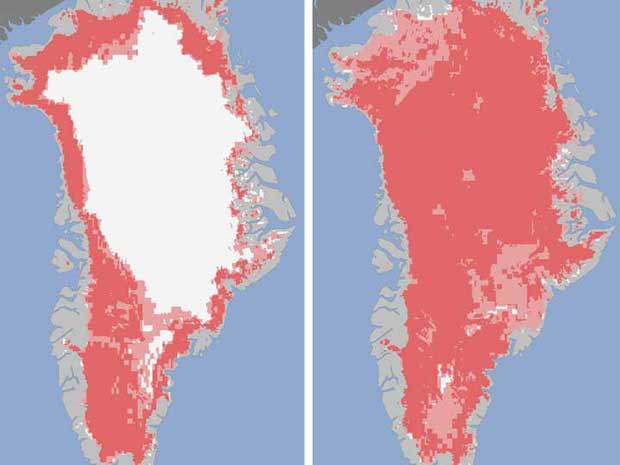
The vast ice sheet of Greenland underwent a remarkable transformation for a few days this month when scientists observed an unprecedented melting of its frozen surface.
For the first time since satellites began recording changes to Greenland from space more than 30 years ago, scientists observed surface melting across almost the entire ice sheet – the second largest body of ice after Antarctica.
The ice sheet holds enough water to raise global sea levels by 7.2m.
The phenomenon in Greenland was so unusual and unexpected that researchers at Nasa's Jet Propulsion Laboratory (JPL) in Pasadena, California, initially could not believe what they were seeing and so quickly sought verification from colleagues elsewhere.
"This was so extraordinary that at first I questioned the result: was this real or was it due to a data error?" said Son Nghiem, whose job at the laboratory is to analyse satellite radar data.
At this time of the year, about half of the surface of the ice sheet usually experiences some kind of surface melting as summer daytime temperatures rise above freezing point.
However, scientists at Nasa were amazed to discover that on 11 and 12 July surface melting had extended across 97 per cent of the ice sheet – the most widespread melting they have witnessed.
The observation comes just weeks after an iceberg twice the size of Manhattan broke away from the Petermann glacier in northern Greenland and other scientists recorded a rapid loss of floating sea ice further north in the Arctic basin.
Thomas Mote, a climatologist at the University of Georgia, has come up with a meteorological explanation for the highly unusual observation. A ridge of warm air – called a heat dome – has formed over Greenland. Dr Mote said that it was in fact the latest of a series of ridges that had dominated Greenland's weather since the end of May.
"Each successive ridge has been stronger than the previous one," he said.
Experts said the unprecedented melting monitored by satellites might just be a natural event, or it could indicate more serious climate change. "If we continue to observe melting events like this in the coming years, it will be worrisome," said Lora Koenig, a Nasa glaciologist.
The Greenland ice sheet is 2,400km long, 1,100km wide and up to 3km thick. It is believed to be 110,000 years old, but there may have been ice sheets on Greenland for 18 million years or more.
Subscribe to Independent Premium to bookmark this article
Want to bookmark your favourite articles and stories to read or reference later? Start your Independent Premium subscription today.

Join our commenting forum
Join thought-provoking conversations, follow other Independent readers and see their replies